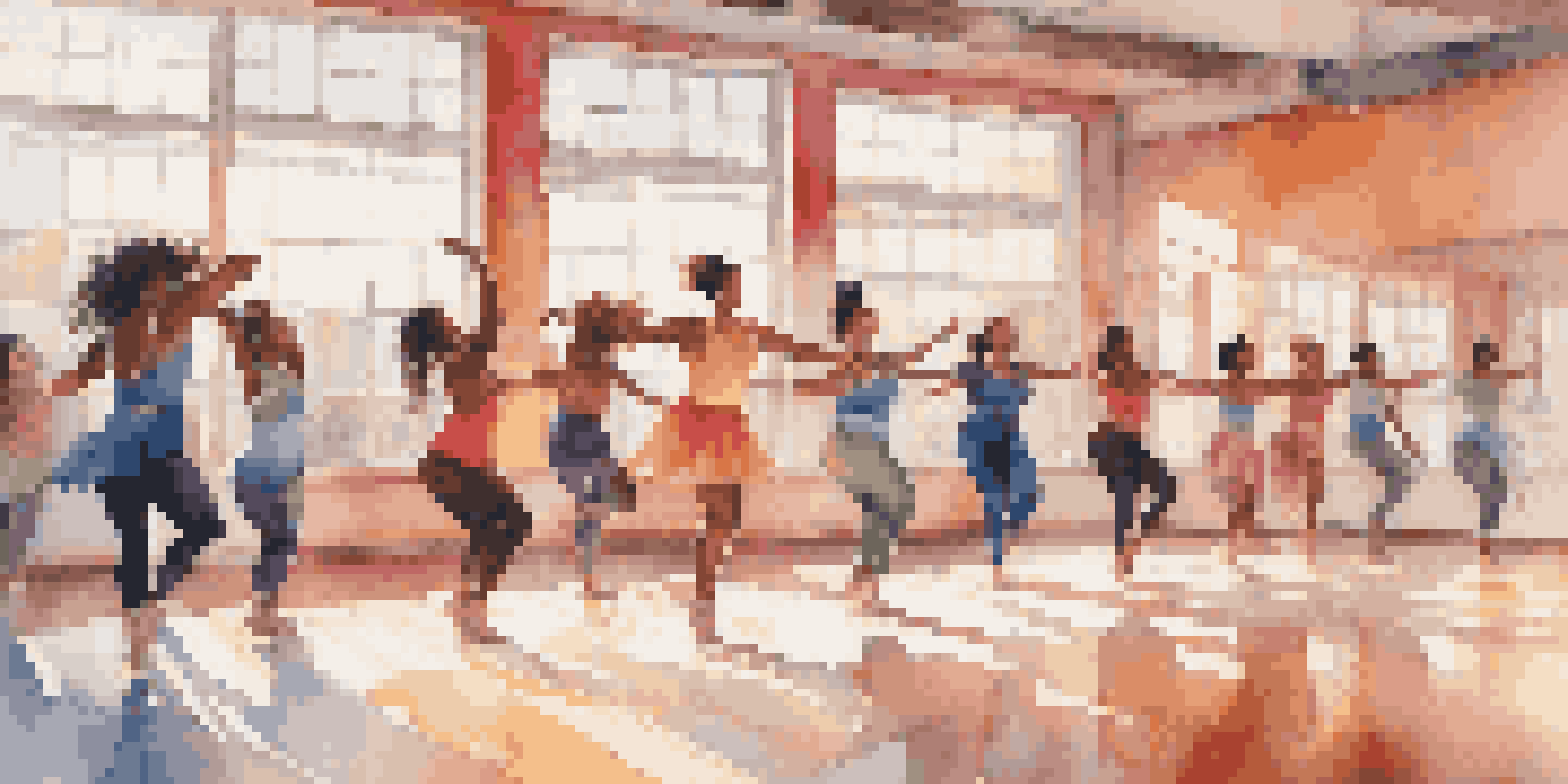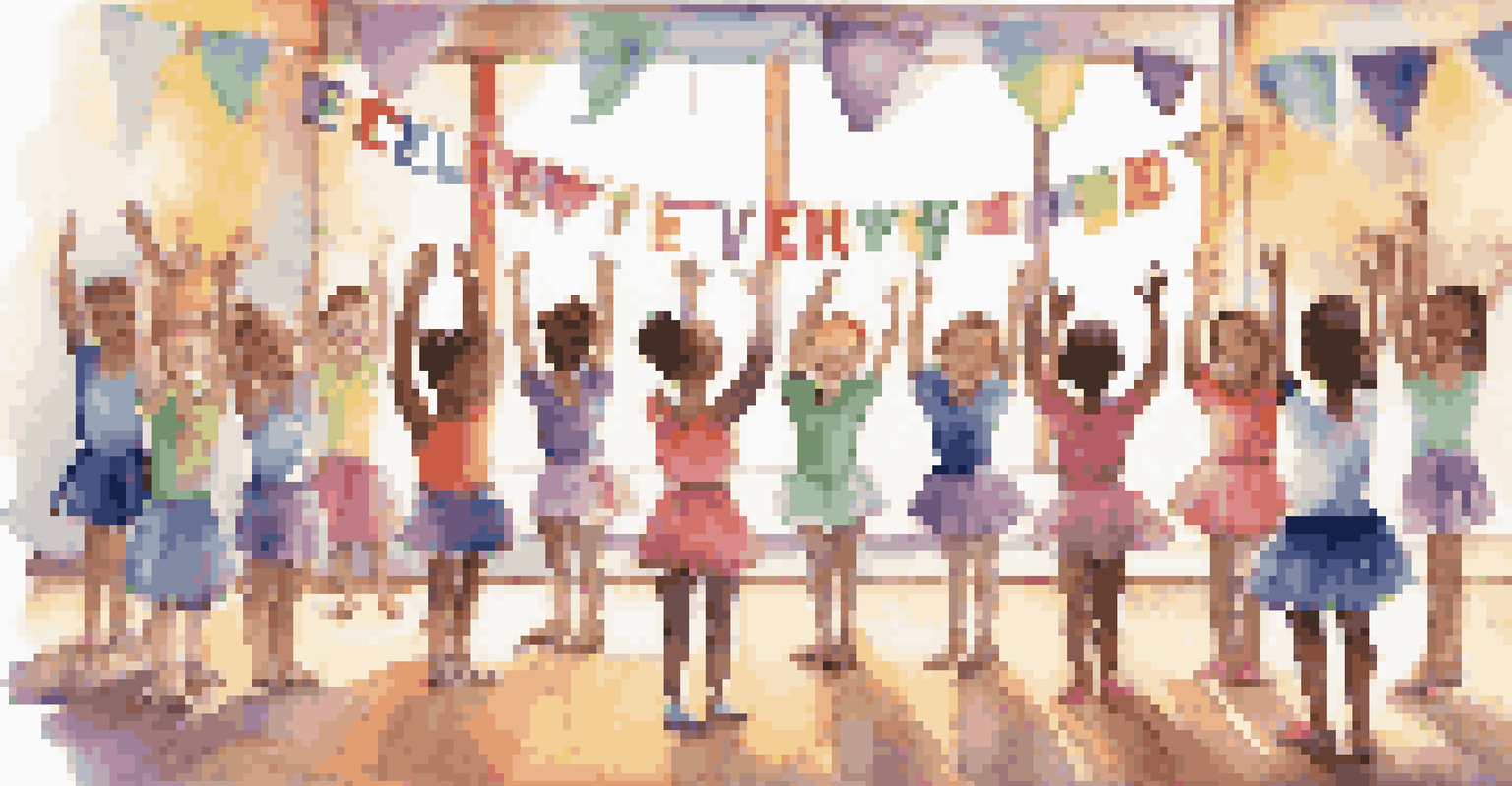Dance Education: Nurturing Body Positivity in Young Dancers

Understanding Body Positivity in Dance Education
Body positivity is about accepting and appreciating all body types. In the context of dance education, it encourages students to embrace their unique shapes and sizes while acknowledging that every body can express movement beautifully. This acceptance is crucial for young dancers, who are often bombarded with unrealistic standards from social media and performance culture.
Dance is the hidden language of the soul.
By fostering body positivity, dance educators can create a supportive environment where students feel valued for their individual talents rather than their appearance. This shift in focus can lead to increased confidence and a love for dance that transcends physical limitations. Consequently, it cultivates a healthier mindset toward one's body and capabilities.
Moreover, body positivity in dance education helps dismantle harmful stereotypes that can discourage participation. When students see diverse body types represented in their classes and performances, it reinforces the idea that dance is for everyone, regardless of size or shape.
The Role of Dance Educators in Promoting Body Positivity
Dance educators play a pivotal role in shaping the attitudes of young dancers towards their bodies. By consciously promoting body positivity in their teaching methods, they can instill a sense of self-worth and acceptance among students. This can be achieved through language, encouragement, and the celebration of diverse bodies in class discussions.

Creating a curriculum that highlights body diversity can also be beneficial. Incorporating teachings from various dance styles and cultures allows students to appreciate the beauty of different movements and physical expressions. This exposure helps students recognize that there isn't one 'ideal' dancer’s body but rather a spectrum of possibilities.
Embrace All Body Types in Dance
Body positivity encourages dancers to appreciate their unique shapes, fostering self-acceptance and confidence.
Additionally, educators can model body positivity by sharing their own experiences and challenges. When teachers openly discuss their journeys with body image, it fosters an atmosphere of trust and authenticity, encouraging students to share their own stories and struggles.
Creating a Supportive Dance Environment
A supportive dance environment is essential for nurturing body positivity among young dancers. This includes promoting kindness, respect, and encouragement among peers. When students feel safe and supported by their fellow dancers, they are more likely to embrace their bodies and celebrate each other’s differences.
The body is the instrument of our creativity.
Dance studios can implement policies that discourage body shaming and promote inclusivity. Activities such as group discussions on body image and self-esteem can be woven into the curriculum to reinforce these values. Through these discussions, students can learn to recognize and challenge negative thoughts about their bodies.
Moreover, educators should celebrate achievements beyond physical appearance, such as creativity, teamwork, and personal growth. By shifting the focus from looks to skills and character, students can develop a deeper appreciation for their own bodies and the bodies of their peers.
Incorporating Body Positivity into Dance Techniques
Incorporating body positivity into dance techniques is about teaching movements that celebrate the body’s capabilities. Educators can focus on functional movement and the joy of dance rather than adhering to strict aesthetics or technical perfection. This approach not only enhances physical abilities but also reinforces a positive self-image.
Encouraging students to explore their own movement styles and expressions can also foster a sense of ownership over their bodies. When dancers are allowed to interpret choreography in ways that feel good to them, it promotes individuality and self-acceptance. This personalization can be incredibly empowering.
Educators Shape Body Image Attitudes
Dance educators can promote body positivity by celebrating diversity and sharing their own experiences with body image.
Additionally, educators can introduce exercises that emphasize body awareness and appreciation. Mindfulness practices, such as yoga or guided imagery, can help students connect with their bodies and develop a loving relationship with themselves, which is essential for their overall well-being.
The Impact of Performance and Competition on Body Image
Performance and competition can significantly impact young dancers' body image, often leading to pressure and unrealistic expectations. However, dance education can shift this narrative by emphasizing personal growth and enjoyment over competition. By fostering a culture that values passion and creativity, students can focus on their love for dance rather than their appearance.
Educators should prepare students for the realities of competition by discussing the importance of self-acceptance and resilience. By helping dancers understand that not winning does not equate to failure, they can build a healthier mindset around performance. This shift can reduce anxiety related to body image and performance outcomes.
Furthermore, celebrating participation and effort in performances, rather than just results, can help students feel appreciated for their dedication. Recognizing individual progress and achievements fosters a sense of belonging and pride, which is essential for maintaining a positive body image.
Engaging Parents and Guardians in Body Positivity
Engaging parents and guardians in the conversation about body positivity is crucial for reinforcing the values taught in dance classes. When families understand the importance of body acceptance, they can support their children’s journeys both inside and outside the studio. Educators can organize workshops or informational sessions to educate parents on promoting body positivity at home.
Encouraging open communication about body image between students and their families can also be beneficial. When parents model healthy body talk and self-acceptance, it influences how children perceive their own bodies. This support network can empower young dancers to embrace their uniqueness and resist societal pressures.
Supportive Environments Matter
Creating a nurturing dance environment helps students feel safe, valued, and encourages them to embrace their individuality.
Additionally, creating opportunities for families to celebrate their children's achievements, irrespective of appearance, can strengthen this bond. By fostering a positive home environment where body image is discussed openly, students can feel more confident and secure in their identities as dancers.
The Future of Body Positivity in Dance Education
The future of body positivity in dance education looks promising as more educators recognize its importance. As the industry evolves, there’s a growing emphasis on inclusivity and diversity, pushing the boundaries of traditional dance norms. This shift is essential for creating a more accepting and empowering landscape for young dancers.
Advancements in social media and digital platforms also play a role in promoting body positivity. Dancers and educators can share positive messages, relatable experiences, and diverse representations of dance online, connecting with a wider audience. This visibility can inspire young dancers to embrace their bodies and express themselves freely.

Ultimately, the journey towards body positivity in dance education is ongoing. By continuing to advocate for acceptance and celebrating diversity, we can ensure that the next generation of dancers feels confident, empowered, and proud of their bodies as they express themselves through the art of dance.